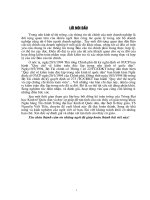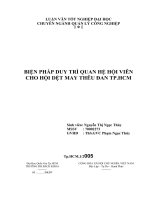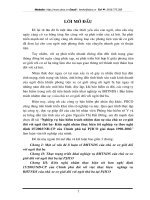APLIKASI SPEKTROSKOPI INFRAMERAH DAN KEMOMETRIKA DALAM ANALISIS KEHALALAN PRODUK
Bạn đang xem bản rút gọn của tài liệu. Xem và tải ngay bản đầy đủ của tài liệu tại đây (3.79 MB, 57 trang )
APLIKASI SPEKTROSKOPI INFRAMERAH
DAN KEMOMETRIKA DALAM ANALISIS
KEHALALAN PRODUK
Abdul Rohman
Ketua PUI-PT Institute of Halal Industries and
Systems (IHIS), Universitas Gadjah Mada,
Yogyakarta
2021
Presented at Faculty of Pharmacy, UHAMKA
Sabtu, 11 Desember 2021
OUTLINE PRESENTASI
• Pendahuluan Analisis Halal
• Spektroskopi Inframerah
• Kemometrika
• Aplikasi Spektroskopi IR-kemometrika untuk
analisis kehalalan produk
– Sediaan Farmasi
– Makanan
INTRODUCTION TO HALAL ANALYSIS
• Halal authentication analysis is intended to confirm
that the products (food, cosmetics, pharmaceuticals)
are free-non halal-components
• The advanced technology in the industries has led to
the use of non-halal components in the product.
– Pork
– Lard
– Porcine gelatines
• Montowska and Pospiech (2010) reported that some
food and pharmaceutical products available in the
market may be labelled with incorrect or missing
information related to ingredients sources.
Montowska, M., & Pospiech, E. (2010). Authenticity determination of meat and meat products on the
protein and DNA basis. Food Reviews International, 27(1), 84–100.
ANALYSIS OF NON-HALAL COMPONENT
Non-halal components • To comply with halal requirement,
commonly found in food, more stringent auditing/monitoring
cosmetics and system is needed by Halal
pharmaceutical products Authorities or Certification Bodies
are pig derivatives (lard,
pork, porcine gelatin) and • Reliable state-of-the-art scientific
alcohol methods are required for analysis of
non-halal components (e.g porcine
origin, alcohol) in halal food
• Analytical techniques become major
challenge for authentication of halal
products
METHODS FOR HALAL AUTHENTICATION
• Lard
– FTIR spectroscopy, especially combined with chemometrics (Lard,
lipid based food)
– GC-MS (certain fatty acids in lard)
– Differential scanning calorimetry (Lard, lipid based food)
– Electronic nose or fast gas chromatography (analysis aroma
profile)
• Pork
– Real-time PCR
– Enzyme immunosorbent assay
• Porcine Gelatin
– RT-PCR (DNA-based methods for analysis of porcine DNA and non-
allowed meat DNA)
– LC-MS (peptide profile)
METHODS FOR HALAL AUTHENTICATION
• Screening/exploratory
– Differential scanning calorimetry (Lard, lipid based food)
– Electronic nose or fast gas chromatography (analysis aroma
profile)
– FTIR spectroscopy
• Confirmatory
– RT-PCR (DNA-based methods for analysis of porcine DNA and
non-allowed meat DNA)
– LC-MS-MS (peptide profile)
– GC-MS (certain fatty acids as markers in lard)
STANDARD METHODS
• Candidate of standard method
– Lard: GC-MS
– Pork: DNA based method
– Gelatin: LC-MS/MS and PCR based methods
• To be standard methods, analytical techniques
used must be:
– Specific
– Accurate
– Precise
– Sensitive
– Robust
SPEKTROSKOPI INFRAMERAH
• Spektroskopi mempelajari interaksi
antara radiasi elektromagnetik (EMR)
dengan bahan (sampel)
• Jenis Spektroskopi
– Spektroskopi sinar X
– Spektroskopi UV-vis
– Spektroskopi inframerah
– Spektroskopi NMR
– Spktrometri massa
RADIASI ELEKTROMAGNETIK
Infrared Spectroscopy
• Infrared spectroscopy (IR spectroscopy or
Vibrational Spectroscopy) is the spectroscopy that
deals with the infrared region of the
electromagnetic spectrum, that is light with a
longer wavelength and lower frequency than
visible light.
• It covers a range of techniques, mostly based on
absorption spectroscopy.
Infrared Radiation
• Frequencies - 12800 to 10 cm-1
– (cm-1 = wavenumbers)
• Divided into three Regions
– Near : 12800 to 4000 cm-1
– Middle: 4000 to 400 cm-1
– Far: 400 to 10 cm-1
50
INFRARED SPECTROSCOPY
IR spectroscopy is based on the interaction between EMR and
matters (samples) in IR regions
FTIR spectroscopy
Rapid and sensitive
Non destructive
Ease in sample presentation
used for qualitative
quantitative analyses
FINGER PRINT TECHNIQUE
Scanning Spektra IR
Absorbansi = Analisis kualitatif dan
kuantitatif
Transmitans = Analisis kualitatif
PEMINDAIAN SPEKTRA INFRAMERAH: ABSORBANSI
PEMINDAIAN SPEKTRA INFRAMERAH: TRANSMITANS
FTIR SPECTRA OF LARD AND OTHERS
Rohman et al. (2011): JAOCS Jumlah Puncak (peak) /Bahu (shoulder)
Intensitas (absorbansi atau transmitans) puncak/bahu
Frekuensi eksak tiap puncak/bahu






